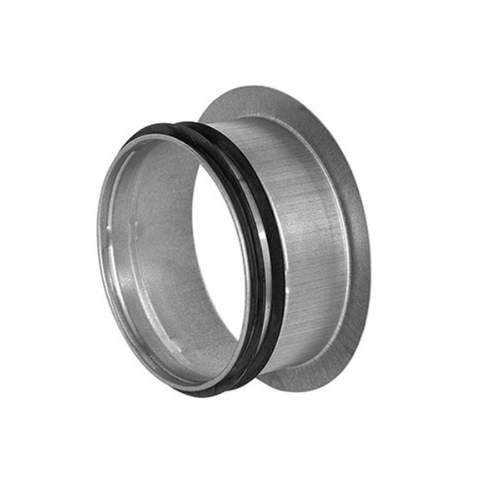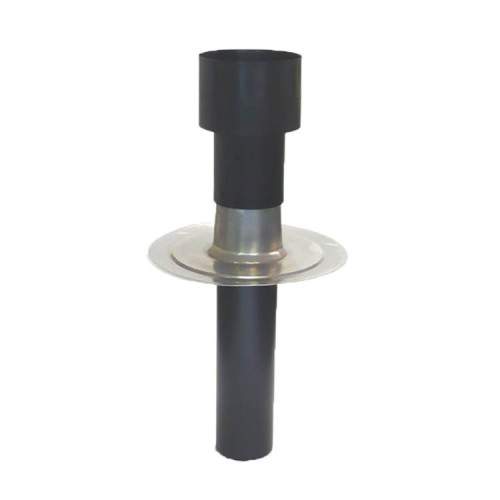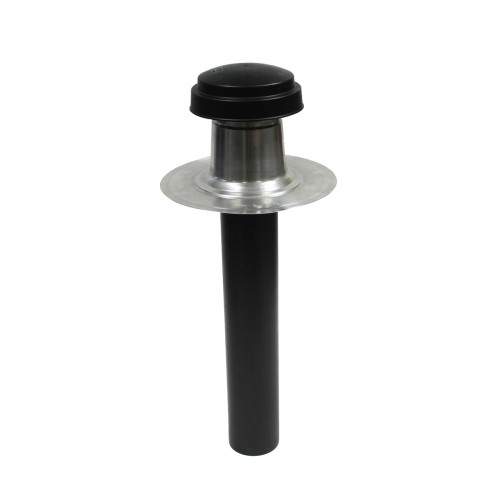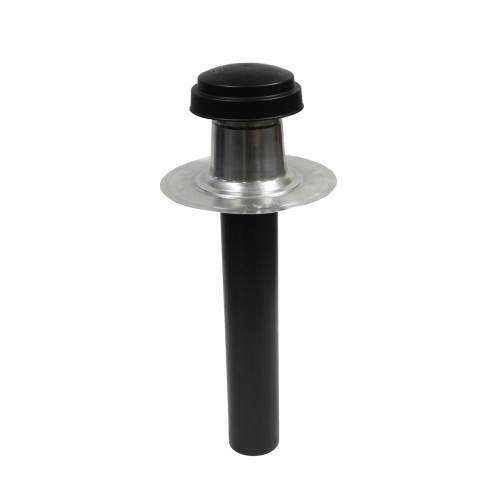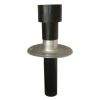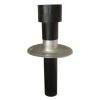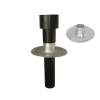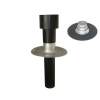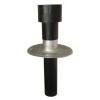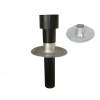A soil vent pipe (SVP) is a vertical pipe used to drain sewage from a building. It can also be referred to as a soil stack pipe, stink pipe or drain waste vent, and its principal purpose is to regulate pressure in the drainage system. Traditionally, SVPs were made of cast iron, but most properties now have a uPVC alternative.
Soil vent pipes are a critical part of any drainage system. Without a vented pipe, a vacuum would build up behind the wastewater as it moves down the pipe. This would force the water out of u-bends, in turn allowing foul odours and gases to enter the property.
Table of contents
- How does a soil vent pipe work?
- Soil vent pipe materials
- How to install a soil vent pipe
- Maintenance of soil vent pipes
How does a soil vent pipe work?
Vent pipes allow air to be drawn into the pipe, balancing the drain pressures. This is important because if the pressure isn’t balanced, you may experience positive and negative pressure when there’s a sudden flow of water inside the pipe.
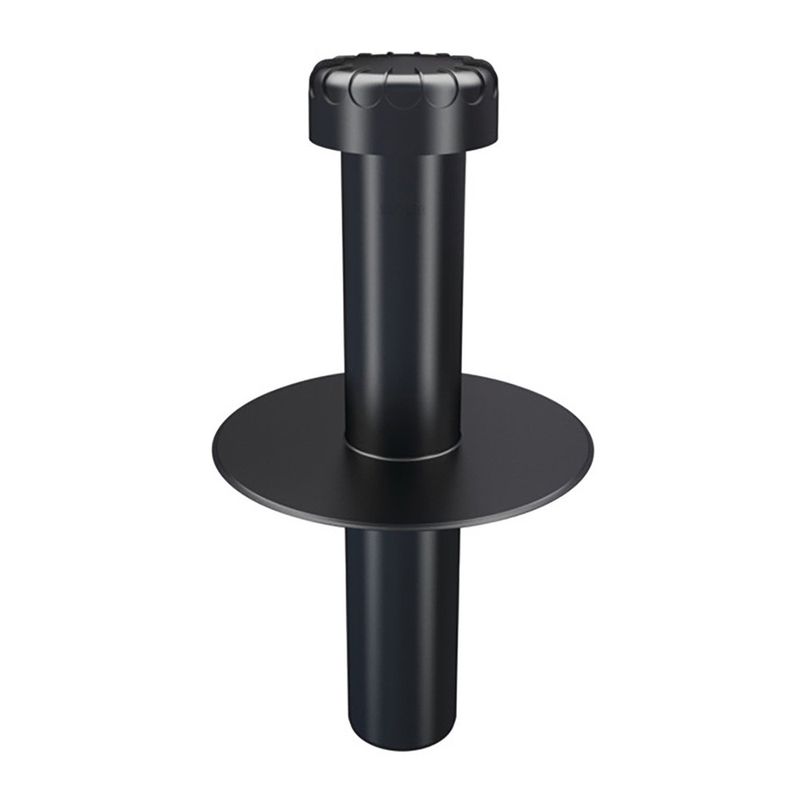 In extreme but rare circumstances, positive pressure can result in water being pushed back up the traps and into the appliance. Negative pressure is a much more common problem. If you have negative pressure in the system, it causes the water seal in a trap to be sucked out. The result of this is foul drain smells entering the property via the empty trap.
In extreme but rare circumstances, positive pressure can result in water being pushed back up the traps and into the appliance. Negative pressure is a much more common problem. If you have negative pressure in the system, it causes the water seal in a trap to be sucked out. The result of this is foul drain smells entering the property via the empty trap.
It’s important to note that an SVP works slightly differently from a waste pipe. While a soil vent pipe carries water from the toilet, urinal and bidet from your home to the sewer, a waste pipe carries used water from your sinks, shower, washing machine and bath.
Soil vent pipe materials
Traditionally, SVPs were made of cast iron, but more modern properties tend to feature a plastic vent pipe. These uPVC pipes can be combined with a host of adaptors and connectors to give you a complete and durable drainage system. You’ll find a range of diameter options on the market. An added benefit is the choice of colours available, allowing you to pick one that perfectly complements your property.
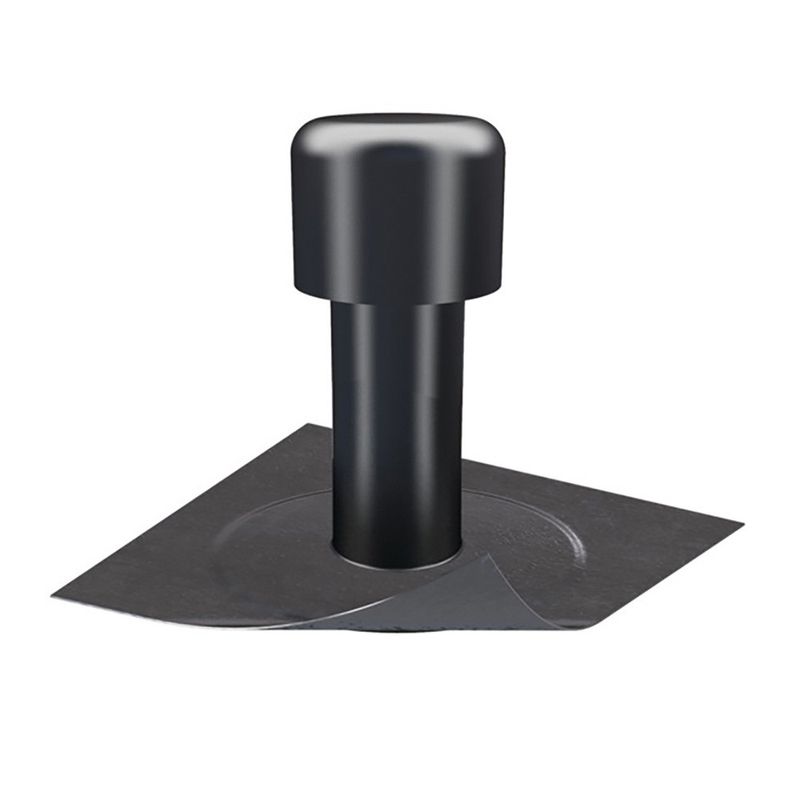 Cast iron SVPs are extremely low maintenance and benefit from a long lifespan. Although more expensive, they’re well suited to commercial buildings and apartments. This is because they’re high-density cast iron, which reduces noise pollution created by water travelling through pipes. They’re also extremely fire resistant and withstand higher temperatures than their uPVC counterparts.
Cast iron SVPs are extremely low maintenance and benefit from a long lifespan. Although more expensive, they’re well suited to commercial buildings and apartments. This is because they’re high-density cast iron, which reduces noise pollution created by water travelling through pipes. They’re also extremely fire resistant and withstand higher temperatures than their uPVC counterparts.
Cast iron soil vent pipes
There are many benefits of installing a cast iron SVP. They’re easy to fit, have a long lifespan (over 100 years in some cases), and are low maintenance. Typically, a cast iron soil vent pipe requires little more than an annual inspection, which usually results in minimal repairs, if any.
A huge advantage of using cast iron is that your SVP will not deflect under heavy loads. This means you don’t have to worry about the effects of intense rain or snow. Although cast iron soil vent pipes are more expensive than plastic, you get the benefit of an extremely long lifespan from a product that is 100% recyclable. Cast iron SVPs also use a large proportion of scrap and recycled metal during the manufacturing process.
uPVC plastic soil vent pipes
Plastic SVPs are lightweight, which helps reduce transportation costs and installation time, making them a cheaper alternative to cast iron. Their smooth internal surface means there’s less chance of materials getting stuck and causing blockages. Plastic soil vent pipes also benefit from a strong chemical resistance, so the long-term use of bleach and toilet cleaner tends not to have a detrimental effect.
Due to their low cost and long lifespan, uPVC soil vent pipes are often considered the most cost-effective option. You’ll find two types of plastic SVP on the market – Push Fit and Solvent Weld. The former is fitted without needing sealant or glue. The latter requires solvent cement to create a join between the pipes and fittings.
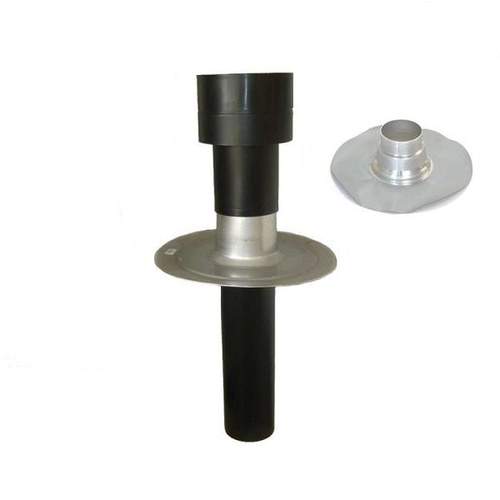
How to install a soil vent pipe
Several elements are involved with installing an SVP, but if you’re a confident DIY-er, it could be a job you want to complete yourself. As for any measurements you take, this next point may sound trivial, but it’s vital you’re confident with any measurements you take. This is because you’ll need to cut pipes to the specific dimensions required for your property.
Before you install an SVP, you must locate (or create) the hole that goes through your bathroom wall to allow internal pipe fittings to exit the property. Your first measurement will be from the bathroom wall hole to the stop within the drain. When you’re satisfied with the figure, you can cut the first piece of pipe to size. Do this before you begin connecting the bathroom pipes to the exterior drain. Our step-by-step guide to installing a soil pipe breaks down the process into eight easy-to-follow stages.
What’s the difference between Push Fit and Solvent Weldpipe fittings?
If you go down the plastic SVP route, you can choose from two different types of pipe connectors. These are push-fit SVPs or solvent-weld SVPs.
Push-fit SVPs are fitted without the need for sealant or glue. Instead, they are pushed together and sealed by a small rubber ring in each section of pipework. On the other hand, we have solvent-weld pipes, which require solvent cement to be joined together.
There is no right or wrong in terms of the connectors you choose. The main difference is that push-fit joints can be taken apart again, whereas solvent-weld joints are permanent. As push fit is quicker to install and easily rectifiable, it tends to be a favourite among DIY enthusiasts. However, it’s advisable to use solvent-weld connectors in any areas where there’s the potential for impact to the system. An example of this could be on a public building.
How high should a soil vent pipe be?
It’s not quite as simple as deciding where you want the vent to be placed, as the position of a vent in a soil pipe is stipulated by building regulations.
Approved Document H outlines the drainage and waste disposal building regulations in England for foul water drainage and disposal. It states that the opening of ventilating pipes should be located at least 900mm above any building that’s within three metres of the pipe. The vent is also required to be protected with a wire cage or perforated cover to prevent debris or birds from entering it.
Air admittance valve vent
An air admittance valve (AAV) is an alternative option to fitting a vent in a soil pipe – a soil pipe vent if you will. It opens automatically when water enters the soil pipe and closes when the water has passed into the drain.
Properties with internal SVPs will benefit from a reduction in heat loss due to the lack of a continuously open vent. Where an AAV is used, a vent must be installed elsewhere in the property’s drainage system, although this can be some distance from the property.
Installing an AAV does reduce the risk of condensation, which can accumulate on surfaces around an internal vent stack. Sometimes unwanted smells are released, gargling sounds can be heard, or wastewater comes back up the soil pipe and into the sink. These issues are signs there could be a problem with your AAV.
Maintenance of soil vent pipes
SVPs generally have a long lifespan, and to maximize this, it’s worth inspecting them each year to check for any damage. There’ll likely be nothing of note, but it’s good to detect a problem early to stop it from developing into a more complex situation.
What can block a soil vent pipe?
If you do detect a problem with your SVP, chances are it’ll be a blockage in the system. This is one of the most common maintenance issues with SVPs. In fact, this is an issue that has risen in recent years with the introduction of disposable wet wipes. Even wipes that claim to be flushable can get caught in SVPs and cause a partial or complete blockage in the system.
If a pipe is cracked or ill-fitted the risk of a blockage can be increased. To work efficiently, the pipe needs a smooth, fast flow of water. Without this, it can be easily interrupted by a pipe crack or a build-up of rust. That’s why cast iron SVPs are more prone to such blockages.
How can I tell if my soil vent pipe is blocked?
If your SVP is blocked, the usual signs include your toilet draining slowly and foul smells being released from the drains. Some people also report ‘ghost flushing’ from their toilet as a result of an SVP blockage. Although the vent pipe should be fitted with a protective cover, blockages can be caused by bird nests, tree debris or even tennis balls.
How to clean a soil vent pipe
There are no two ways about it: cleaning an SVP is messy. Although it can be tempting to save money and do it yourself, this is really a job for professionals. If you’ve been trained in SVP cleaning and are determined to tackle this job yourself, remember to wear protective clothing. This is required due to the heavy gases that can build up inside the pipes, which can be flammable. Drainage cleaning experts will be able to use high-pressure water jets to clean the vent pipe and eliminate blockages. This should reduce any unpleasant drainage smells and is usually completed quickly and efficiently.
When to call a professional
It’s always best to be cautious when dealing with your property’s drainage system, especially if you’re not trained in this area. If you notice a crack or leak in the pipework and you’re not confident you can repair it, the best thing to do is call a plumber. Don’t be afraid to call an emergency plumber if the problem you detect requires immediate attention.
Similarly, if your soil vent pipe becomes blocked, an emergency drainage engineer can quickly clear the blockage and scour the pipes to minimise the risk of a second blockage forming. Some drainage specialists have equipment that enables them to provide remote assistance. So, if you’re troubled by an SVP blockage, always call an expert.


